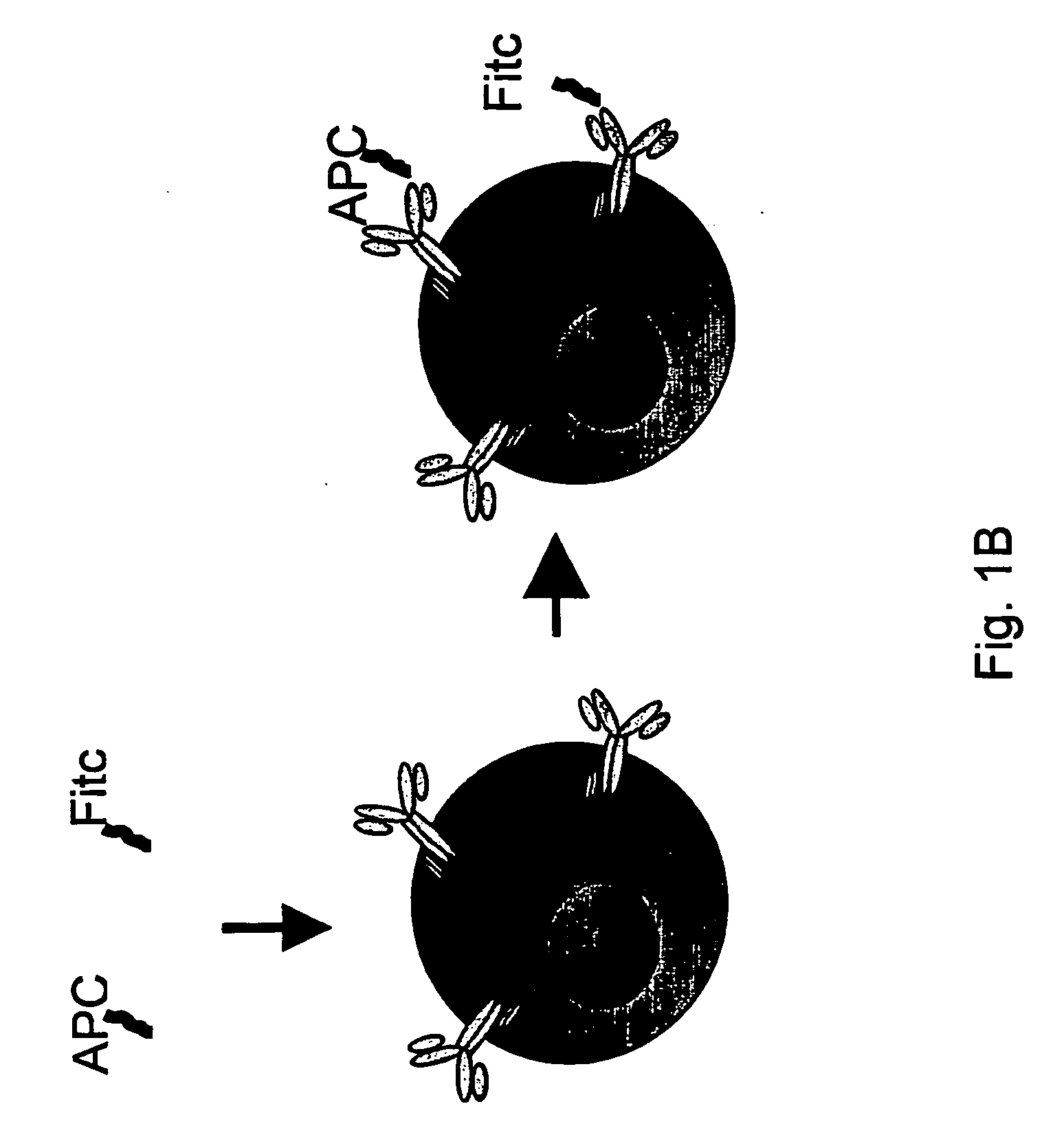Early B-cell detection for selecting vaccines
- Summary
- Abstract
- Description
- Claims
- Application Information
AI Technical Summary
Benefits of technology
Problems solved by technology
Method used
Image
Examples
example 1
Detection of Low-Frequency Early B Cells.
Materials and Methods
Animals
[0172] Six eight-week-old mice were used and were treated according to the ethical guidelines of our institutions. Mice were immunized intraperitoneally on day 0 with GnRH-TDK coupled with ovalbumin (100 μg) or with Gastrin-TDK1 coupled with diphtheria toxoid (Pepscan Systems, Lelystad, NL), in Complete Freunds Adjuvant. Control mice were not immunized. On day 7, half of the mice of each group were boosted, using Incomplete Freunds Adjuvant, and half of the animals were sacrificed and spleens were harvested. On day 14, spleens were harvested from the remaining mice. All animal experiments were done with permission from the local ethical committee (DEC).
Tetramer Synthesis
[0173] Tetrameric molecules were produced by mixing equal volumes of C-biotinylated, middle biotinylated or N-biotinylated GnRH at 200 μM (Pepscan Systems) with R-phycoerythrin (PE)-labeled neutravidin at 3.3 μM (PE-NA, Molecular Probes, Eu...
example 2
Comparison of the Immunogenicity of GnRH-Derived Peptides.
Materials and Methods
Animals
[0189] Six eight-week-old mice were used and treated according to the ethical guidelines of the University of Utrecht. Mice were immunized intraperitoneally on day 0 with GnRH-like peptides conjugated to ovalbumin (OVA). We prepared three different peptides, i.e., GnRH-monomer (pEHWSYGLRPGC (SEQ ID NO:1)), GnRH-tandem (pEHWSYGLRPGQHWSYGLRPGC (SEQ ID NO:2)) and GnRH-tandem dimer (TDK, the dimerized form of pEHWSYkLRPGQHWSYkLRPGC in which “k” represents a D-lysine residue) (Pepscan Systems, Lelystad, NL), in Complete Freunds Adjuvant. Control mice were not immunized. On day 7, half of the mice of each group were boosted, using Incomplete Freunds Adjuvant, and half of the animals were sacrificed and spleens were harvested. On day 14, spleens were harvested from the remaining mice. All animal experiments were done with permission from the local ethical committee (DEC).
[0190] Cell cultivation. Ce...
example 3
Comparison of the Immunogenicity of Gastrin-Derived Peptides.
[0195] With the above-described method, we compared four different peptide formulations of Gastrin to vaccinate the mice.
mono Gastrin:pEGPWLEEEEC#;(SEQ ID NO:7)tandem Gastrin:pEGPWLEEEEQGPWLEEEEC#;(SEQ ID NO:8)Gastrin TDK 1:pEGPWLEEEEQGPWLEEEECK#(see, SEQ ID NO:8) |pEGPWLEEEEQGPWLEEEECK#andGastrin TDK 2:pEGPWLEEEEEAYkQGPWLEEEEEAYkC#(see, SEQ ID NO:8) |pEGPWLEEEEEAYkQGPWLEEEEEAYkC#
[0196] These peptides were tested as a vaccine in mice and at seven and 14 days after immunization, specific B cells were detected with the method of the invention using tetramer Gastrin peptide. The following biotinylated gastrin peptide was used to form a tetramer: pEGPWLEEEEEAYGWMDFK($)# (SEQ ID NO:6), wherein #=amide; pE=pyroGlutamine and K($)=biotinylated Lysine.
[0197] The results of the double-tetramer staining assay are presented in FIGS. 6A and 6B. The results clearly show that Gastrin TDK2-...
PUM
| Property | Measurement | Unit |
|---|---|---|
| Pharmaceutically acceptable | aaaaa | aaaaa |
| Immunogenicity | aaaaa | aaaaa |
| Affinity | aaaaa | aaaaa |
Abstract
Description
Claims
Application Information
 Login to View More
Login to View More - R&D
- Intellectual Property
- Life Sciences
- Materials
- Tech Scout
- Unparalleled Data Quality
- Higher Quality Content
- 60% Fewer Hallucinations
Browse by: Latest US Patents, China's latest patents, Technical Efficacy Thesaurus, Application Domain, Technology Topic, Popular Technical Reports.
© 2025 PatSnap. All rights reserved.Legal|Privacy policy|Modern Slavery Act Transparency Statement|Sitemap|About US| Contact US: help@patsnap.com



